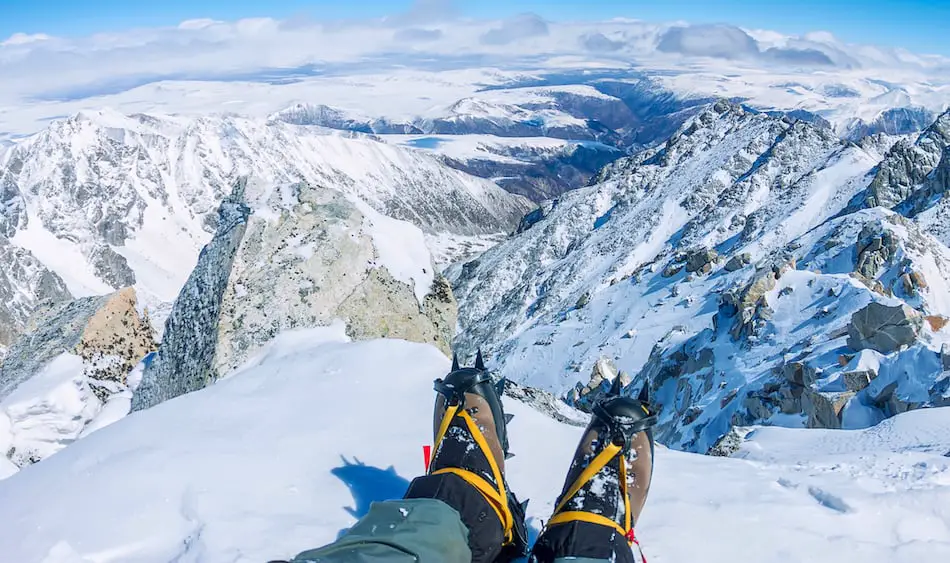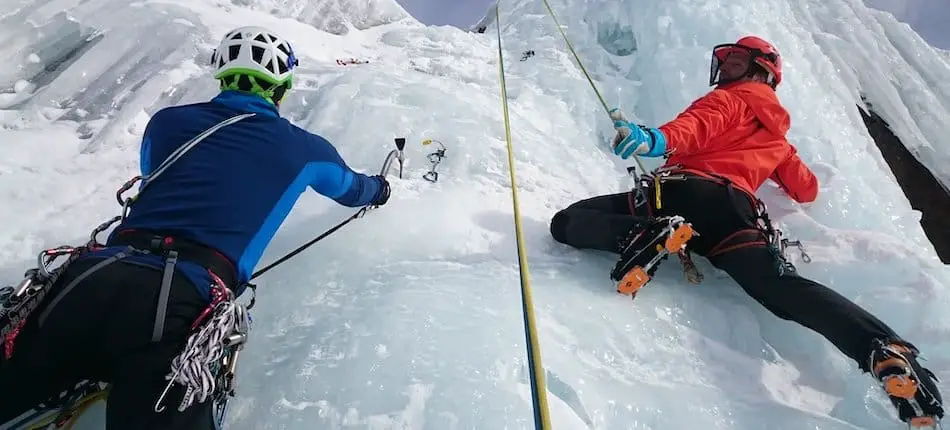
Snow pants are expensive, and it can be annoying constantly needing to purchase new pairs. I’ve written the following article to explain what you can do about this.
So, will you tear your pants ice climbing? Yes, there is a good chance that your pants will get ripped while ice climbing, particularly if you’re a beginner. This usually happens when you catch a crampon on the ankle of your pants, although it can also be caused by your ice axes or the rock.
Tearing your pants is one of the most common inconveniences that happens to ice-climbers, be they a beginner or an experienced veteran. Remember, when ice climbing, you have a lot of sharp objects strapped to your body that you’re not used to being there, namely the crampons on your feet and the axes in your hand. Crampons especially are infamous for causing tears; it’s incredibly easy to misjudge a step and catch one of the points in the fabric around your ankle. Given how sharp the equipment is, it’s almost a given that the pants will rip upon contact.
In the following article I talk about why this happens, how to fix it, and some strategies to avoid doing it in the future
Why Your Pants Get Ripped

If you want to know why your ice climbing pants get ripped, just pay attention to how you walk throughout the day, especially if you’re a bit of a klutz. Try to notice how often you accidentally catch one foot on the other, try to itch your leg with your shoe, or even just allow your toes to brush close to your pants. Now, in all of these scenarios, pretend that you have a one-inch knife strapped to the edge of your shoe.
That’s essentially the situation when you’re ice climbing. Crampons are designed for biting into rock-hard ice and glacial surfaces; they’re sturdily constructed and sharpened to a vicious point. The outside of most pairs of snow-pants, while being waterproof and built to resist a decent amount of wear and tear, are by no means Kevlar. They can withstand a lot of things, but slashing motions aren’t one of them.
When you go ice climbing the first time, you might find that you cause a lot more harm to your ice pants than do your more experienced friends. The first time I ever went, I literally shredded the inside hem of an old pair of ski pants— wore them down until they were literally in strands.
Why does this happen? After all, even beginner ice climbers know how to walk properly, and people don’t bang their legs together that much… do they?
Well, yes and no. In day-to-day life, while wearing sneakers and on flat terrain, it’s not that difficult to walk normally and not get tangled up in your own feet. Wearing mountaineering boots for the first time, however, just feels weird. They’re bulky and inflexible, the ankles are super stiff, and they feel like a pair of cinderblocks taped to your feet. This can throw off your gate and make walking normally difficult.
You also factor in walking around in crampons, which is a whole other level of strangeness. Your feet stick in place and you’re taller than you’re used to; it can be hard to keep track of where your leg is.
Additionally, take into account that most people’s snow pants aren’t super tapered. This causes them to billow near the ankles, meaning there’s a lot of fabric flapping around to be caught on the sharp point of a crampon. Combined with you not knowing exactly what it feels like to walking in boots and crampons, it’s the perfect recipe for a few missteps.
Finally, this isn’t an event that’s isolated to walking around. Kicking into ice is a strange feeling the first few (see: several dozen) times that you do it. If you’re on your first ever ice route, pumped from gripping your axes and trying to gain purchase on a frozen waterfall, it’s easy to rush your kicks and accidentally misplace one too close to your opposite leg.
So, in short, why do you rip your ice pants while climbing? Because crampons are sharp, walking in mountaineering boots feels weird, and you might not always be paying perfect attention to where you place your feet.
How to Fix Ripped Pants
Snow pants, like most things in the outdoor apparel industry, are expensive. Purchasing a new pair of pants every time you get a rip in them is costly and time-consuming (not to mention bad for the environment). At the same time, however, you don’t want to be walking around with holes in your pants. This can ruin their thermal ability and make you look like a bit of a gumby.
Thankfully, there are a couple of strategies you can use to repair the rips at the end of the day.
Tape
Tape is the go-to method for fixing ice climbing pants once they’ve been torn. I’m not talking about duct tape, either; I mean speciality outdoor-apparel repair tape, which can be bought at most outlets and comes with a slew of advantages.
Repair patch tape, as it is often referred to, is specifically designed for outdoor clothing to stick in place and stay there for the lifetime of the garment. It’s adhesive on Gortex, waterproof, easy to apply, and super cheap (especially compared to the price of a tailor).
Personally, I like using Gear Aid Tenacious Tape, because it costs $7 per roll and can be applied at home. Better yet, it’s multi-purpose: the tape can also be used for sleeping bags, air mattresses, tents, and just about anything else that you want to waterproof.
To use the tape, simple cut it into a round shape that’s a little bit larger than the tear you want to fix, peel the sticky backing off, and place it on the garment. Make sure to press down on the edges in an outwards motion to really get it to stick, and then leave it overnight so that the adhesive can dry.
For small to medium tears, this stuff is the cheapest and easiest way to restore the function of your clothing. My ice climbing partner probably has 20-30 patches on his pants. Sure, they might not look the most presentable, but very few people are going to care once you’re in the outdoors.
Warranty
Taping your pants isn’t for everyone, and some tears might require more attention than you can provide yourself. In these instances, it’s always a good idea to look to the company that made the pants in the first place.
Patagonia, for example, has a rock-solid lifetime warranty that they’ve stuck with to this day. Just recently I tore my brand-new jacket on my ice pick (that’s what I get for not strapping my axes on correctly). The company didn’t even ask questions when I brought it in; they just shipped the jacket away for repairs.
Warranties will do a better job than tape in terms of repairing your pants to their original function. Not every company will have the same scope of coverage, however, so it’s important to do your research beforehand. Additionally, warranties can sometimes take up to 6 weeks before you get the item of clothing back, which is a long time to go without your ice climbing pants.
Strategies to Avoid Ripping Them

Now that we’ve covered why ice climbing pants get ripped, let’s move on to some preventative measures.
Before we continue, however, I need to include a quick disclaimer: if you’re a beginner ice climber, there is a strong chance that you’re going to tear your pants, even if you follow every single step in this guide. I can’t prevent that from happening, but that strategies below can minimize the impact/frequency.
Technique
The first, most obvious, and most difficult solution: fix the way you walk.
Now, I know that sounds dumb, but hear me out. As I said above, the majority of ice climbing rips happen simply because you put your feet in the wrong place. By familiarizing yourself with the feeling of walking around in ice climbing boots and crampons, you can minimize the amount of times you forget where your feet are and inadvertently cause a rip.
Now, this is clearly easier said than done. A lot of this comes with experience, which you won’t have on your first few outings. For the beginners out there, refer to the strategies below.
Gators
Gators have a dual advantage when it comes to protecting your ice pants: they offer an extra layer of fabric, and they keep the pants tight to your ankles. This make it harder to catch them by accident and less likely that you’ll rip them once you do.
However, gators have an equal downside: if you wear them, you’re risking your crampons slicing through both the gators and the pants at the same time. Suddenly, you’ve ruined two pairs of garments in one misstep.
If you have an old pair of gators lying around that you don’t care about, this can be a great option. When it comes to using your favourite pair of Gortex backpacking ones, however, it might be best to skip out on this particular technique.
Reinforced snow pants
For the shopaholics out there, there’s always a solution that can be bought. In the ice climbing world, this comes in the form of reinforced pants.
Some alpine pants, such as the Outdoor Research Cirque, come with a reinforced patch of fabric on the inside of each ankle that helps add a layer of protection to the pants. This reinforcement will prevent you from tearing your pants with any minor snags.
However, as with the gators, this additional fabric isn’t going to stop your crampons from ripping into the pants when you get a good solid swipe in. The reinforced pants aren’t a perfect solution, but they can add a nice layer of protection. Plus, the reinforced section can often be repaired with tape (as mentioned above), so if you’re thinking of getting into ice climbing, it can be worth picking up a pair of these.
Tape
And now for the most ghetto solution of all: tape.
In this instance, I actually am talking about duct tape, or any equivalent of it that will work for what you need. For some people (see: myself, the first time I went ice climbing), it’s not worth it to spend any extra money trying to reinforce your pants, because they’re just going to get ripped anyways.
What you can do, however, is minimize the extent of that damage. Taping the ankles of your ice pants won’t offer much in the way of protection, but it can tighten the hems by a significant degree, meaning that there’ll be less fabric swishing around and less chance of you accidentally catching yourself with your boot.
Conclusion
So, there we go! That’s everything I know on why you might tear your pants while ice climbing, how to repair them, and how to stop it from happening in the first place. Thanks for reading!
